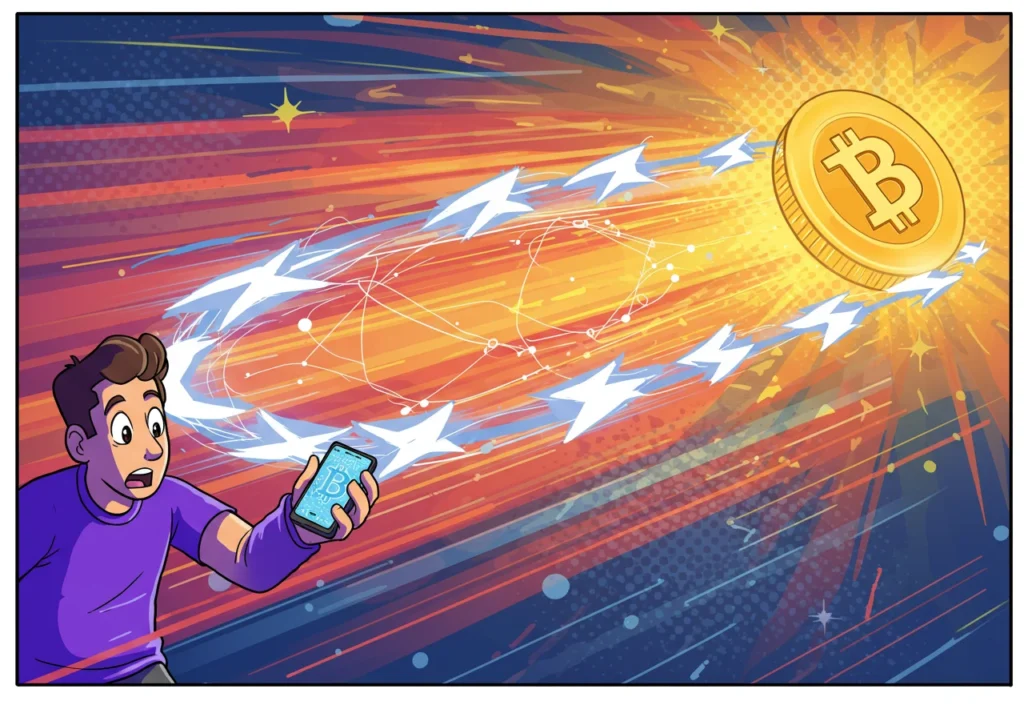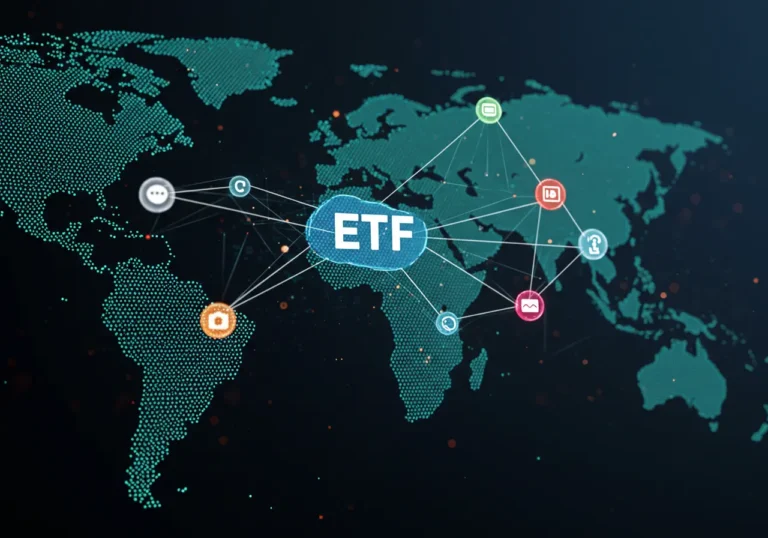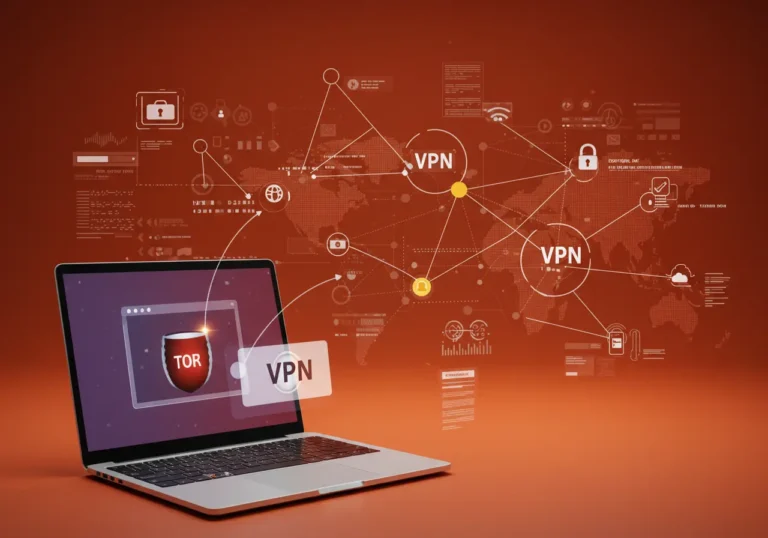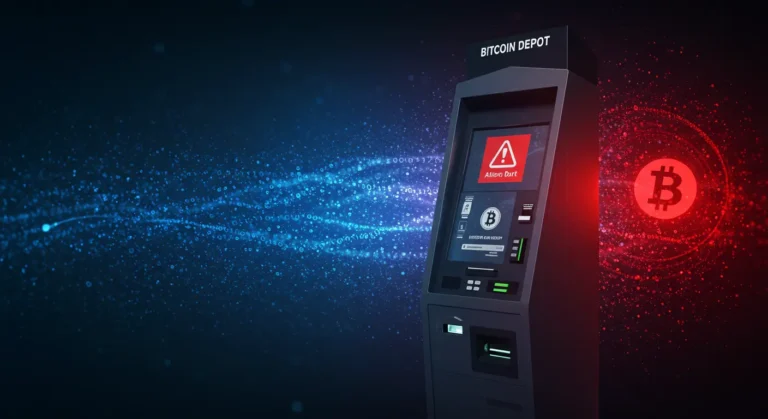What is Bitcoin Lightning? A Guide to Faster Transactions
What is Bitcoin Lightning: in short, it’s a second-layer network built on top of the Bitcoin blockchain that enables near-instant, low-cost payments. Instead of recording every small payment on the main Bitcoin ledger, Lightning moves many of those payments off the chain into private channels. Only the setup and final settlement of those channels touch the main blockchain. This design keeps the core security of Bitcoin while making everyday payments practical.
Bitcoin Lightning Network explained

How does it actually speed things up and reduce fees? The core idea is payment channels.
A payment channel is like a private tab between two people. Alice and Bob open a channel by making an on-chain transaction that locks some Bitcoin into a shared address. From that moment, they can update who owns what share of that locked amount as many times as they like. Those updates are exchanged off-chain and happen instantly. When they finish, they close the channel and the final balance is published on the Bitcoin blockchain.
Because only opening and closing transactions are on-chain, millions of tiny payments can happen without overloading Bitcoin. That’s the essence of the Bitcoin Lightning Network explained in practical terms.
Why this matters
- On-chain Bitcoin is secure but slow for small payments.
- Lightning lets you send tiny amounts (micropayments) without big fees.
- It keeps the main chain clean for larger, less frequent transfers.
Benefits of Lightning Network
There are clear Benefits of Lightning Network for everyday users and merchants:
- Speed: Payments settle almost instantly. No waiting for multiple confirmations.
- Low fees: Tiny transactions cost far less than on-chain transfers.
- Micropayments: You can pay tiny amounts—useful for tipping or pay-per-use services.
- Scalability: By moving many transactions off-chain, Lightning helps Bitcoin scale to more users.
- Increased privacy: Many payments don’t appear on the public blockchain, improving privacy for routine transfers.
These Benefits of Lightning Network make it suitable for small purchases, content tipping, and fast transfers between friends.
How Lightning Network payment channels work
Understanding Lightning Network payment channels helps you see the safety and speed trade-offs.
- Opening a channel: Alice and Bob create an on-chain transaction that locks funds into a multi-signature address. This is recorded on Bitcoin’s blockchain.
- Making off-chain updates: They exchange signed “balance updates” that say who owns how much. Each update replaces the previous one. No blockchain interaction is needed.
- Routing payments: If Alice wants to pay Carol but has no direct channel, Lightning can route the payment through connected channels (Alice → Bob → Carol).
- Closing the channel: When they finish, the latest balance state is broadcast on-chain and becomes final.
Channels use cryptographic tricks and timed penalties to prevent cheating. If someone tries to broadcast an old state, the other party can claim a penalty. This design keeps the system secure while allowing off-chain convenience.
Lightning Network scalability solution

The Lightning Network scalability solution is about handling many small transactions without changing Bitcoin’s core rules. It allows the network to process far more payments per second than the base layer by shifting most of the workload off-chain.
Think of the Bitcoin blockchain as a busy highway. Adding more lanes is hard. Lightning builds side roads for local traffic so the highway is free for heavy loads. That side-road network scales by adding more channels and better routing, enabling a global web of fast payments.
How to use Lightning Network: practical steps
If you’re ready to try Lightning, here’s How to use Lightning Network in plain steps:
- Choose a Lightning-capable wallet. Options range from custodial apps (easiest) to non-custodial wallets and full nodes (more control). Examples include Muun, BlueWallet, and the Lightning Loop-enabled wallets.
- Fund your wallet with Bitcoin. Send some BTC to your wallet. If the wallet manages channels for you, it will open channels automatically or let you open one.
- Open a channel (if needed). Non-custodial use often requires opening a channel by committing funds on-chain. Custodial wallets may skip this.
- Make a Lightning payment. Scan a Lightning invoice QR code or paste the invoice string. Confirm and pay. The transaction should complete in seconds.
- Receive payments. Generate an invoice in your wallet and share it with the payer.
- Close channels (if you want). When you want your funds back on the main chain, you can close the channel. The final balances are then settled on-chain.
Start small. Use a tiny amount first to learn how payment routing and invoices behave.
Custodial vs. non-custodial: trade-offs
When using Lightning, you’ll choose between convenience and control:
- Custodial services manage channels and liquidity for you. They’re simple and fast to start with, but you must trust the service with your funds.
- Non-custodial wallets keep your keys and give you control. They may need occasional management like channel rebalancing or backups.
- Running your own Lightning node gives maximum control and privacy but requires technical skill and a server that’s reliably online.
Pick what you’re comfortable managing.
Common challenges and how to handle them
Lightning is powerful but has some real-world issues:
- Liquidity: Channels must have funds in the right direction to route payments. If a route fails, retrying or opening channels can help.
- Routing failures: The network is improving, but sometimes payments fail if no suitable route exists. Retry or increase the payment fee.
- Watchfulness for fraud: If you run your own node, you should monitor it to protect funds from potential on-chain fraud attempts.
- User experience: Wallets are improving, but Lightning involves more steps than a simple on-chain send.
Most wallets and services handle many of these problems automatically, which makes life easier for new users.
Real-world use cases
Lightning makes sense in many daily situations:
- Coffee shops and retail: Fast, cheap payments at the point of sale.
- Tipping creators: Tiny tips while reading articles or watching streams.
- Microtransactions for services: Paying per article, minute, or action.
- Cross-border small transfers: Cheaper and faster remittances for small sums.
These use cases show how Lightning can broaden Bitcoin’s usefulness beyond large transfers and investments.
Privacy and security notes
Lightning improves privacy by keeping many payments off the public ledger, but it’s not perfectly anonymous. Routing paths, channel balances, and node behavior can leak information in some cases. For strong privacy, learn how channels and routing work, use privacy-focused wallets, and consider using techniques like channel rebalancing.
From a security angle, non-custodial setups require key backups and wallet security. Custodial services require trust in the provider and care about their reputation and security practices.
Practical tips for beginners

- Start with small amounts you can afford to lose while learning.
- Use well-reviewed wallets and services.
- If running a node, keep software updated and secure.
- Explore custodial wallets for ease, then graduate to non-custodial or self-hosted setups as you learn.
- Learn basic troubleshooting: how to retry payments and check channel status.
Conclusion — faster Bitcoin for everyday use
What is Bitcoin Lightning? It’s a powerful second-layer network that makes Bitcoin fast, cheap, and practical for everyday transactions. By using Lightning Network payment channels and smart routing, people can send micropayments in seconds without overloading the Bitcoin blockchain. The Benefits of Lightning Network are clear: speed, low fees, and scalability. If you want to pay with Bitcoin for coffee or tip a creator a few cents, Lightning is the right tool today.
As wallets and infrastructure improve, Lightning will become simpler and more seamless. For now, it offers a practical path to use Bitcoin in daily life while preserving the main chain’s security.
Key takeaways
- What is Bitcoin Lightning: a second-layer network for fast, low-fee Bitcoin payments.
- Bitcoin Lightning Network explained: open channels, transact off-chain, close channels on-chain.
- Benefits of Lightning Network: speed, low fees, micropayments, privacy improvements, and scalability.
- How to use Lightning Network: choose a wallet, fund it, open or use channels, and send/receive invoices.
- Lightning Network scalability solution: moves small transactions off-chain to reduce load on Bitcoin’s mainnet.
- Lightning Network payment channels: allow many instant updates between two parties without touching the main ledger.
Frequently Asked Questions
Q: Can I use Lightning for large transfers?
A: Lightning is primarily optimized for small and medium payments. For very large transfers, on-chain transactions provide direct settlement and are often preferred.
Q: Is Lightning safe?
A: Yes, when you use reputable wallets or custodial services. Running your own node requires careful setup and monitoring to maintain safety.
Q: Do Lightning payments appear on the Bitcoin blockchain?
A: Only channel openings and closings are recorded on-chain. The many intermediate Lightning payments are not.
Q: Do I need to keep my node online all the time?
A: If you run your own node, staying online helps avoid channel issues and protects against certain attacks. Many users rely on wallet services that manage uptime for them.
Q: How do I receive Lightning payments if I don’t have a channel?
A: Some wallets and services provide inbound liquidity solutions so you can receive payments without manually opening channels.
Table of Contents

Hello, I’m Edmilson Dias, founder of CoinBringer. I created this platform to guide people through the fast-moving world of cryptocurrency with clarity and safety. With years of research in blockchain and digital security, my goal is to translate complex topics into practical knowledge, offering reliable tutorials, safety insights, and guidance for both newcomers and experienced users.
Discover more from CoinBringer
Subscribe to get the latest posts sent to your email.







